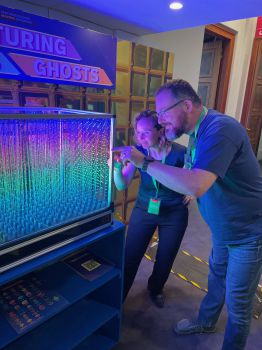Three Sussex science projects selected for prestigious Royal Society Exhibition
Posted on behalf of: Alice Ingall
Last updated: Wednesday, 3 July 2024

Challenging newborns to a dance-off, discovering distant galaxies and unlocking the Universe's secrets are just some of the curiosities that University of Sussex academics are inviting the public to explore at a major science event from 2 – 7July.
University of Sussex scientists are hosting three exhibits – out of 14 of the main stands on show – at this year’s prestigious Royal Society Summer Science Exhibition. The Summer Science Exhibition, which is held at the Royal Society in central London, is an annual, free showcase of cutting-edge science selected by the Royal Society – the world's oldest scientific academy. The Exhibition provides a unique opportunity for members of the public to talk to world-leading scientists from UK universities and science institutes about their work and get hands-on with science.
Vice-Chancellor of the University of Sussex, Professor Sasha Roseneil, said:
“It is an honour to have three University of Sussex exhibits selected for the 2024 Summer Science Exhibition, and it is testament to the fantastic range of world-leading scientific research taking place at Sussex.
“Taking cutting-edge science out of the lab and making it come alive for the general public is something that these Sussex scientists are particularly brilliant at – and passionate about. I’m thoroughly looking forward to visiting the Exhibition. I would encourage people of all ages to get down there and explore this free celebration of scientific discovery.”
The three University of Sussex Royal Society Summer Science Exhibition 2024 exhibits are:
University of Sussex Professor of Comparative Cognition, Gilly Forrester and her ‘Me, Human’ team, will be showcasing their evolutionary development research, investigating how we became the upright walking, talking, tool-using great apes that we are today.
Visitors will be invited to participate in ‘The Great Ape Challenge’ and ‘Just Dance Now’ style ‘Baby Boogie!’ activities. ‘Baby Boogie!’ shows how social development can be traced back to how we move our bodies during the first days of life, challenging participants and a competitor to test their movement skills against those of a newborn infant. The interactive game demonstrates just how difficult it is to imitate the complex and variable movements associated with healthy cognitive development.
‘The Great Ape Challenge’ puzzle boxes will challenge visitors to retrieve a ‘food reward’ and test how their problem-solving skills compare to chimpanzees, gorillas and orangutans. They will learn how puzzles can represent language structure and syntax, with the complexity of the puzzle aligning with ability for complex language.
James Webb Space Telescope’s first years of discovery
The James Webb Space Telescope (JWST) is our most advanced window to the Universe. Its unprecedented resolution and sensitivity are now revolutionising our view of the cosmos, providing new insights into our own Solar System, probing the atmospheres of extrasolar planets, and discovering the most distant galaxies in the Universe.
Two years on since the JWST’s first observations of the Universe, this exhibit will give the public the opportunity to meet some of the UK scientists, led by Head of Astronomy at the University of Sussex, Professor Stephen Wilkins, working with the Telescope and explore some of its stunning first discoveries.
Through hands-on activities and high-resolution visuals, visitors to the JWST exhibit will be able to learn about the study of alien planets, the formation of the first black holes, and where stars are born. The exhibit features contributions from several other UK Universities, the UK Astronomy Technology Centre (UK ATC), and the European Space Agency.
Capturing nature’s ghosts
Senior Lecturer in Experimental Physics, Dr Kate Shaw and Professor of Physics, Simon Peeters from the University of Sussex will explain how the study of ghost-like neutrino particles could reveal the Universe’s secrets.
Dr Shaw and Professor Peeters will uncover some of the ground-breaking physics being undertaken as part of the international science collaboration, the Deep Underground Neutrino Experiment (DUNE). DUNE is using neutrinos to discover the origin of matter vs antimatter, searching for new physics phenomena, and observing a supernova event in our galaxy.
Visitors to their exhibit will be able to explore activities that demonstrate the cutting-edge science behind the DUNE project, including the opportunity to scan their hands to count the number of neutrinos passing through, and an interactive 3D display of the full DUNE project to see how neutrinos are sent 1300km through the Earth to detectors a mile under the ground.
The Royal Society Summer Science Exhibition launches with an adult-only Lates event on 2 July (6pm-10pm), and is then open daily from Wednesday 3 to Thursday 4 July, 10am – 4.30pm, including to schools, and Friday 5, Saturday 6 and Sunday 7 July, 10am-6pm. Family activities will be available on the weekend.

